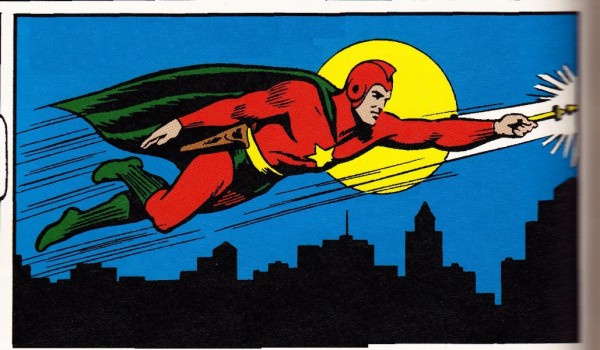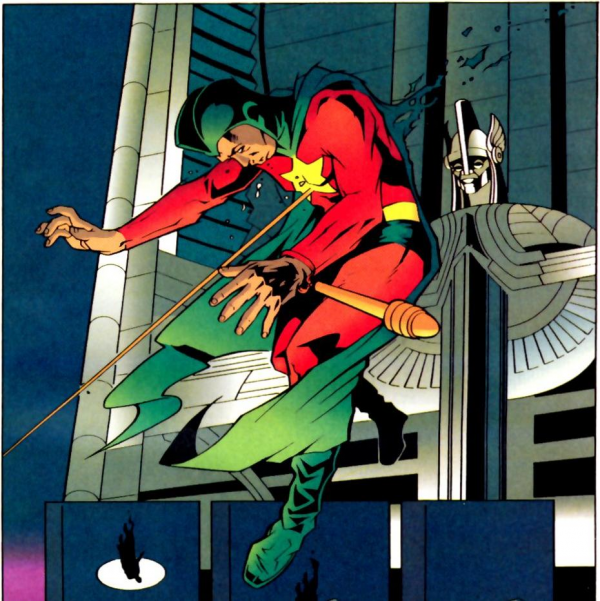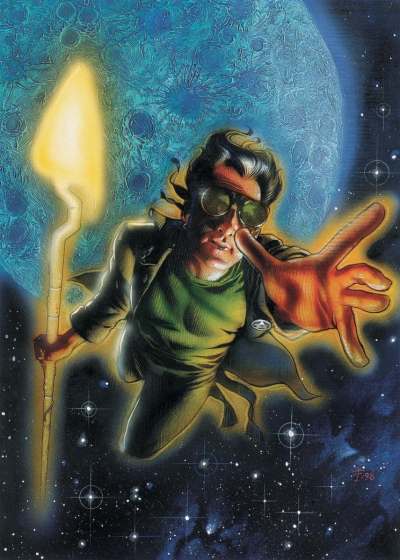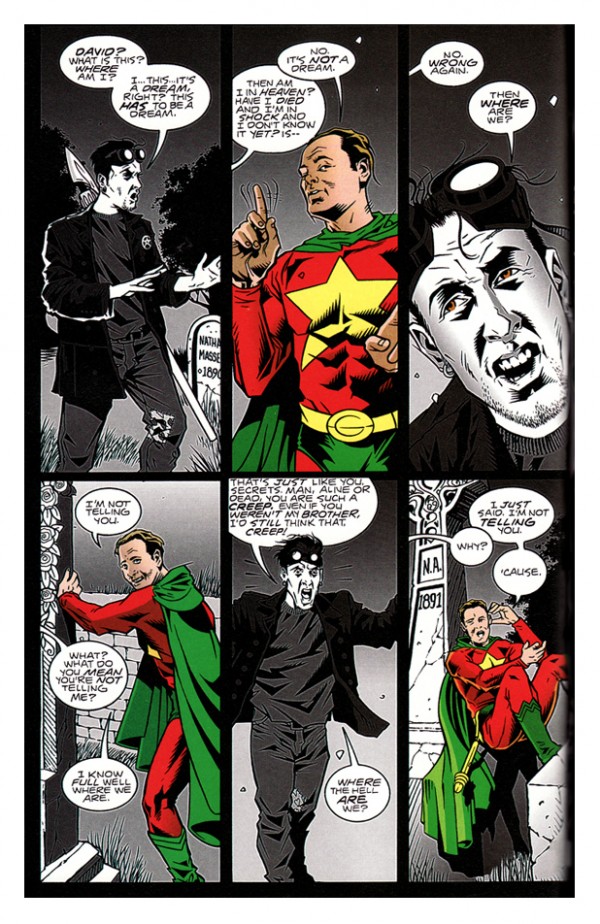Mild-mannered reporters by day, Greg Phillips and Nick Duke share an intense love of comic books that has made them the Hard Traveling Fanboys. Over the course of their travels through comicdom, they have encountered numerous stories through the wonder of trade paperbacks and graphic novels. Once a month, Nick and Greg will review one of those collections in The Longbook Hunters.
Greg: Hello, one and all! Your friendly neighborhood fanboys are back for the third installment of The Longbook Hunters. This monthly column is dedicated to a different trade paperback or graphic novel, and this month we tackle our first omnibus collection. The Starman Omnibus Vol. 1 is our topic, and it collects the first 17 issues of the 1994 Starman ongoing series, written by James Robinson and illustrated mostly by Tony Harris and Wade Von Grawbadger.
Nick: This was my first experience with Starman, while Greg has been hooked on the series for a while now, though I don’t believe either of us were really aware of it at the time of its single issue releases.
Greg: That seems as good a place as any to start the discussion. Starman was a book that completely slipped under my radar when it first hit stands. It wasn’t until I got online in the early 2000s that I started to hear buzz around this series and character I’d never given a second thought. How did you first hear about Starman, both the character and the book?
Nick: Honestly, other than a few mentions and appearances of the Golden Age Starman in issues of Green Lantern and Justice League that I read during my massive endeavor to read every appearance of Hal Jordan, I was completely oblivious. It wasn’t until you told me about you tracking down the Omnibi that I heard anything about this series.
Greg: The book received heavy praise from the online reviewers and writers I read at the time on sites like Comics Nexus. By then, though, the run had ended and the books were out of print. It wasn’t until I found the first trade collection, “Sins of the Father,” on sale at a local bookstore that I had a chance to read the series. Other than the occasional Justice League story, I wasn’t even familiar with writer James Robinson. Did you have any knowledge of Robinson’s work prior to reading this book?
Nick: Not really. James Robinson is one of those names that I’ve heard a lot, but I’ve never really read any of his work other than the Batman story “Face the Face,” which I enjoyed immensely. I’ve also heard good things about his run on New 52 title Earth 2.
Greg: Ah yes, come to think of it, “Face the Face” was probably the first Robinson story I read, and it was a good one. Before we delve into the actual content of this Omnibus, let’s talk a little bit about what readers need to know before turning the page. The series is all about Jack Knight, the son of original Starman Ted Knight, who fought during World War II and the rest of the Golden Age. Ted and his generation of heroes were allowed to age into their twilight years just before Starman hit the stands. How much did you know about DC’s Golden Age lore before reading this one, and is it important to have that cursory knowledge before delving into Starman?

Nick: Oh, man, outside of some knowledge of Alan Scott and the original Justice League annual “Crisis” stories, my knowledge of DC’s Golden Age continuity was pretty much nonexistent. However, as the story unfolds, I think it does a good enough job of helping you to understand the backstory of each character. I’m sure there are some things there for longtime fans, but I don’t think you really need an extensive knowledge of the Golden Age in order to enjoy and understand the story.
However, it does deal with some of the other characters to don the mantle of Starman, and there I did feel like I was missing something, particularly in the case of Mikaal Tomas.
Greg: I support that line of thinking. I grew up reading DC Comics books, but I still didn’t have a strong knowledge about the original Justice Society or All-Star Squadron lineups. I knew of them primarily through the Zero Hour crossover event, which took place concurrently with the beginning of Starman.

However, I found the book did a great job of showing us the bits of history we needed to see while not getting lost in the muck of (at that point) 60 years of continuity. With that said, the book starts us out with Jack Knight, a slacker in his 20s who isn’t exactly his father’s favorite son. His brother is the current Starman, but within a few pages, things are turned on their head and Jack is thrust into a role he never wanted. What were your impressions of the beginning of this book, the origin of Jack Knight?
Nick: It’s a very startling way to begin a book, as Jack’s brother David, the then-holder of the Starman mantle, is murdered in the first few pages. We get to see a glimpse of Jack’s somewhat antagonistic relationship with his brother via flashback, and then the story starts as both a mystery tale revolving around David’s death as well as an introduction to Jack, who can best be described as…different. He certainly reads differently than most costumed heroes of the DC Universe. He’s a bit abrasive at first, but I warmed up to him over time. Took about six or seven issues, though.
Greg: The opening panels, showing David’s grisly death, instantly gripped me. In that sense, it’s one of the strongest opening pages to an ongoing series I’ve read. By page two, I wanted to know who did this, why they did it and what the heck was up with this weird city.

“Different” is a great way to describe the series’ protagonist. Jack Knight is lazy, selfish and woefully inept when the story begins. This is so unlike the vast majority of DC Universe heroes, and for me that made Jack an interesting read. He lacks the clear driving motivations of someone like Batman, he lacks the inherent moral compass of Superman, but he puts on the goggles and gives it his best shot anyway.
I think part of the reason I was so hooked is that I love the idea of legacy characters. From the Flash to Green Lantern to even Batman, I love the idea that these characters can age and become symbols for future generations. Starman, however, seems to play with this concept and show the burden that goes along with a legacy character, especially one that had been filled by so many aliens and humans over the years.
What do you make of the way Robinson handles the concept of a legacy character in this book?
Nick: It’s probably the best I’ve seen the concept handled. I think because I had no attachment to Starman coming in, I was more willing to accept the mantle being passed, whereas with Green Lantern or Batman, I’m always a bit hesitant to see Bruce or Hal go. But, you’re right in that Robinson introduces an aspect that had largely been unaddressed with previous legacies. The burden Jack feels is one of the best aspects of the series, and I wish more legacy characters would be handled from the approach that it may be more of a curse than a blessing to have to live up to the people who meant so much to you.
Greg: That’s one of the things I think helped me relate to Jack. He’s got these weird, diverse interests, which I can certainly relate to. But Robinson also creates this constant sense of pressure on Jack, from those around him and even from himself. Each mistake he makes is only magnified in his mind by those expectations. I empathized with Jack’s crushing self-doubt and neurosis. One memorable early scene shows a beaten Jack seemingly prepared to die as he falls into the water of Opal City’s harbor, all the while recounting the ways he’d screwed up along the way.

But let’s move away from Jack for a moment and onto what I feel is the second main character of the book — Opal City. A completely original creation of Robinson’s (and Harris’), Opal is to Starman as Gotham is to Batman. The city is vital to everything that happens around Jack and to Jack, and each issue seems to reveal some new level of minutia about the town and its inhabitants. Geoff Johns has mentioned this world-building as being a huge influence on his writing. How did Robinson handle that aspect, and was it effective for you?
Nick: It took a little while, but once Robinson made it through the initial storyline, he was really able to dig into the world-building. I especially found the entry from the Shade’s journal to be an effective means of establishing the city and its history. Then at the end of the volume, we have a story where we see the events of one day from several different perspectives, and thus from different points of the city. As with much of the volume, I thought this aspect really started to click the more issues Robinson got under his belt. Once he was able to establish the character and get the origin out of the way, the book took a giant step forward in quality.
Greg: Opal is interesting in that it shares some characteristics with Gotham, some with Metropolis, and yet it ultimately stands apart from both as its own entity. How would you describe Opal City to someone who hasn’t read the book? How does it compare to other fictional DCU cities like Central City, Keystone City, Coast City and so forth?
Nick: Hmm. I think it’s closest to some sort of amalgamation of Gotham and Metropolis. It’s got the Gothic feel and the griminess of Gotham, while other parts of the city feel pristine and bright like Metropolis. That’s one of the key things — the city has different areas that almost feel like different cities unto themselves, and thus give Opal a very unique, albeit almost disjointed feel. Kind of like a hodgepodge of cultures and architecture coming together to create something greater than the sum of its parts.
Greg: And that collage sort of fits artist Tony Harris’ style. Harris is someone whose art I’d never seen before Starman, but it’s so distinctive that it’s hard to imagine another artist drawing this city. He manages to strike a balance between expressive emotions and some of the creepiest, weirdest imagery you’ll see in comics. How did the art strike you?

Nick: So much shadow. Which isn’t necessarily a bad thing. Every panel is bathed in shadow and the combination of light and dark, even those scenes which take place in broad daylight. It’s some of the best lighting work I’ve seen, and the other aspects of the book give it a rough feel that I believe was intentional and totally works for the stories that are told.
Greg: Speaking of shadow, that takes me into the next character I’d like to discuss: longtime supervillain The Shade, who serves a different role in this book. Here, he’s almost a mentor for Jack, silently leading him (from the shadows, naturally) along on his journey. The Shade is my absolute favorite character in the story, precisely because he’s just so pretentious. Here’s a guy who is so damn smart, smug and cultured that it makes you resent him, but he redeems it by being, for lack of a better term, a badass. By making Shade an immortal, Robinson smartly gives himself the advantage of more than a century of backstory for the character. In this volume, we’re just given tiny teases of Shade’s past, but they only made me hunger for more.
Talk a little about the shadow man and his role in the story.
Nick: Yeah, I don’t think I’m being hyperbolic when I say that the Shade’s few appearances in the volume are the volume’s absolute best pages. He’s not there much in the first volume, but I’m definitely left wanting more of him and his stories from his journals, particularly if they involve pedophile Oscar Wilde. He does seem to be playing a bit of a different role than most supervillains, and I’m interested to see where the story takes him and his relationship with Jack. It’s hard to tell at the moment what his angle is, unless it’s as simple as his stated motivation of simply wanting to protect a city he’s grown to care about.

Greg: I’ve only progressed to the stories contained in the second Omnibus, but that intrigue remains even as we find out more about his history and his strange affinity for Opal.
Before we move on to our overall thoughts, are there any other characters that stood out to you? I found Ted fascinating because, while he initially comes across as a kindly old man, he is decidedly not Father of the Year material. We’re not talking Bing Crosby with a bag of oranges, but he’s also not the most supportive guy in the world. Nash made for quite a villain, especially since I kind of disliked the character at first.
Nick: I think for me, the biggest standouts were the O’Dare family and Robinson’s stellar interpretation of Solomon Grundy. Grundy in particular was presented in a different light than I had ever seen him before, but I loved it. His relationship with Jack, Ted and Mikaal totally worked for me and I genuinely wanted everything to work out for Grundy in the end. The O’Dares seem to be Jack’s main allies, but aren’t as noble as most allies of other DC heroes. I love that each member of the family feels distinct and, most importantly, authentic rather than seeming to be a bunch of noble cop stereotypes.

Greg: Let’s get to the heart of the matter: the book as a whole. I loved it, pretty much from start to finish. The marriage of Harris’ art and Robinson’s wordplay creates a superhero canvas unlike any other I’ve read, and sometimes different is good. While there are three or four arcs included in this Omnibus, it feels like one cohesive story because of the through-lines of Jack’s development, Ted’s growing acceptance and Opal’s changes. What were your overall impressions?
Nick: At first, I wasn’t a huge fan. I thought the first few issues were pretty dull, but once the main players had been introduced and Jack had finally taken up the role of Starman, the series was able to get going. The issue where Jack has a conversation with his dead brother, the story from the Shade’s journal and the “Sins of the Child” storyline, which featured a variety of different perspectives on one 24-hour day were all outstanding and made the volume a worthy read, even if the first few issues were underwhelming. It definitely left me interested in the story going forward, particularly in the Shade.
Greg: The varying perspectives provided a very unique building climax in the story. You don’t often get, for instance, a series of three straight Batman books told from the perspectives of different side characters. I definitely liked the early issues more than you did, but I do agree it picked up steam as it went along. I particularly loved the progression once Jack escapes the evil circus (you’ll have to read it to understand) and gets back to Opal.

I think any fans of traditional superhero books should give this one a shot, because it’s almost like a Vertigo book told through the lens of a straight-up superhero story. That variety could open the door to other, less-traditional fare for the reader. What’s your recommendation to our (hopefully) loyal readers?
Nick: I’d give it a shot, particularly if you’re a reader of the “no capes” variety. It’s a superhero story that isn’t told like your traditional superhero story, and like you said, might appeal to readers whose tastes are more in line with independent or Vertigo books. I’m looking forward to seeing how the story plays out myself.
Greg: And with that, we bring another hunt to an end. This is a book we could probably talk about even more, but since you’re probably falling asleep by now, we’ll go ahead and call it quits. Do you have any thoughts on Starman? Hit us up at our Place to Be email accounts (GregP@placetobenation.com and NickD@placetobenation.com), on the PTB Facebook page or on Twitter at @gphillips8652 and …
Nick: @nickduke87, of course.
Greg: Join us next month when we talk about Nick’s most beloved series, Ultimate Spider-Man! Until then, keep reaching for the stars. But more importantly than that crap, keep reading our weekly columns!
